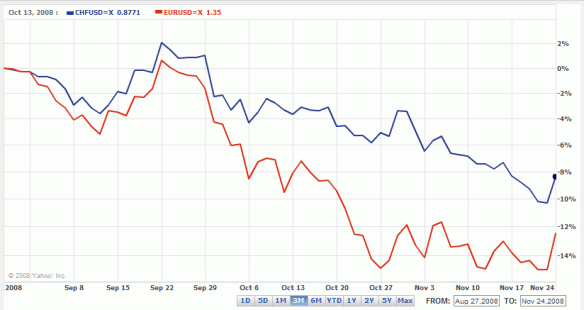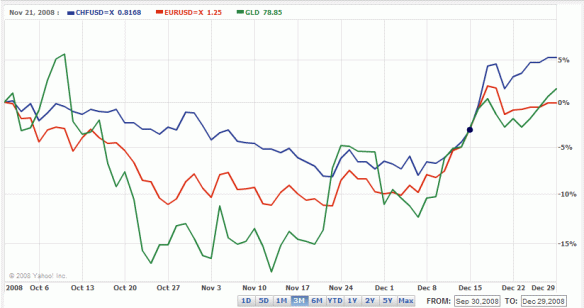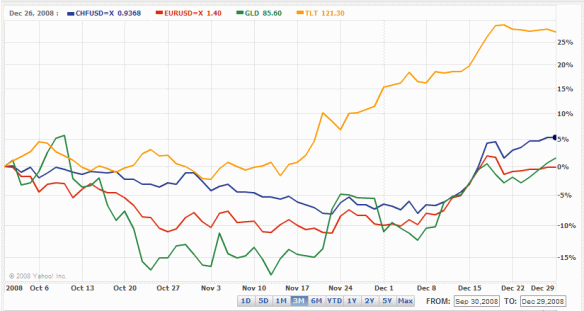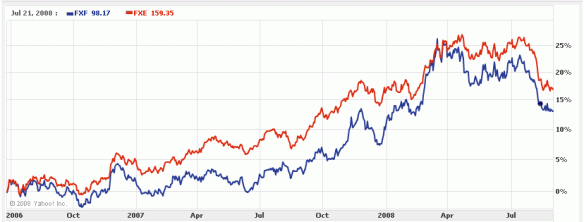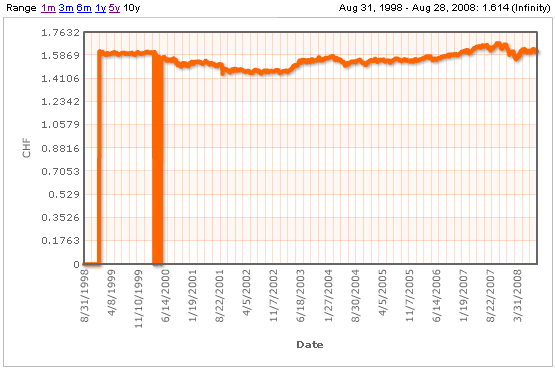The Swiss Franc has been the strongest non-yen, non-dollar currency, and its moves generally coincide with those of the whole “inflation trade” currency basket (CAD, AUD, NZD, BRL, EUR, etc). Its rally looks exhausted:
Tag Archives: swiss franc
Do we finally have an intermediate bottom in the euro and franc?
Last night’s sell-off in risk brought new lows for the euro and Swiss franc, though no other currencies made lows vs. the USD. Now with today’s rally, EUR and CHF have spiked very hard. This jumpiness and the presence of an upslope in RSI bottoms on the hourly chart (and the fact that June would be month 5 of extreme bearishness), suggest that a relief rally could be forming. I would not be surprised by $1.28 for the euro and $.91 for the franc. As usual, I’m not counting on it (the daily chart would look better with a deeper low), but we do have the formula for a short-covering rally.
–
Here’s the 4-hour chart of the franc. There is a strong buy signal here, as the new low was made with very weak selling according to RSI, which stayed in its uptrend.
–
You can see on this daily chart that there is no strong RSI buy signal like there was 15 months ago:
–
A sharp rally here would likely coincide with rallies in stocks and commodities, but I can see the a scenario in which gold and silver do not participate or even fall as everything else rises.
Also, I’m still long-term bearsh on Japanese yen, and this price does not seem like a bad entry for a short (I put one on at $0.01104 this AM, and also shorted Treasury notes for a short-term trade to balance the odds of a rally in stocks & commodities).
Dollar set for a fall?
Checking the early futures action, I see some strength has been building in several currencies vs the dollar over the past few days, despite their longer-term weakness. The dollar enjoyed a small rally against the european set late last week, putting the CHF, EUR and GPB in attractive positions for long trades. With sentiment entering its 5th month of extreme negativity, it may pay to be alert for signs of a rally (that is to say a dollar decline, and further yen decline too against the dollar).
Here are a few charts (1-hour bar), noting the RSI uptrends that have developed:
GBP:
Euro:
CHF:
–
To wrap it up, here is the dollar index futures contract:
Swiss franc and euro look long-term weak, but extremely oversold.
Note the lack of divergence in RSI this time around, compared to late ’08 to early ’09 when CHF and EUR were preparing to rally (see my red arrows on the bottom of this chart).
This suggests that any rally that develops here (and I suspect that one will soon, since they are very oversold on several weeks of dismal trader sentiment) will not be as strong as what we saw in 2009, and that King Dollar is going to reign for a long time yet. Click the chart to enlarge:
TD Ameritrade
Swiss franc oversold and overbearish vs. USD
The franc has taken a beating against the dollar, since it pretty much behaves like a slightly harder euro. Here is an hourly chart (click to enlarge):
TD Ameritrade
Sentiment readings have been super bearish here for a couple of weeks now, so we’re set for a reversal. At the least, going long the franc is not a bad way to hedge a portfolio that is long-term short risk (stocks, junk bonds, commodities).
Euro & Swissie break with the pack
For most of the last couple of years, the non-dollar, non-yen currencies have moved with a remarkable degree of correlation. Priced in US dollars, over a multi-month time frame (and usually even minute-by-minute) there has been little difference between the Euro, the Canadian dollar, the Australian dollar and the British Pound. The correlations are not perfect, and they break apart from time to time (as when the pound had a relatively crappy summer and fall last year). The last couple of days have been terrible for the Euro (white) and its ever so slightly “harder” twin, the Swiss Franc (purple):
Interactive Brokers
–
What to make of this? Well, I have no reason to think that the gap won’t be closed before long. Sentiment on the Euro is so negative that I still think a violent short squeeze is possible, especially if there is continued strength in the equity, commodity and other currency markets.
Another possibility is weakness or sideways behavior in the general risk trade, with the Euro holding a bit firmer than the rest. It is so oversold that something eventually has to give. Of course, as we saw with the dollar from August through November, oversold can become more oversold, but that was a decline of a different nature: a lower slope, with a stair-step pattern. The Euro has basically crashed straight down over the last two months. That pace won’t be sustained for very long without relief rallies like what we’re seeing this week in the other currencies.
As I write, there is some support on of their charts. We’ll see if they bounce or cut through — the latter would be all around bearish and may portend a little panic in stocks, etc.
–
Oh — and how about that Euro/Swiss relationship? How do you explain the Swissie’s moves by the Greece situation? The Swiss National Bank won’t be printing anything to bail out Greece, and in fact might be expected to print less, given their talk of intervening to attempt (foolishly and with no lasting effect) to weaken the CHF vs. their biggest trading partners’ script.
Dollar rally hits gold and Treasuries.
I first touched on this topic last week:
“So that’s what I’m working with. All three asset classes look overbought to me: bonds, gold and the Euro/CHF, and I suspect that their rallies are related and associated in traders’ minds with recent Fed and Treasury actions.”
Today the dollar is rallying strongly against other currencies and gold, which behaves like a volatile currency, and Treasuries are falling sharply. This is a reversal of December’s big moves. The dollar fell as the bond climbed. The two are maintaining a kind of balance — from a foreigner’s perspective, you don’t want to buy Treasuries with high bond prices and a high dollar, since that exposes you to elevated currency risk as well as price risk. As bonds correct their overbought condition, the dollar can rise.
This is just my 2 cents on the last few weeks — bonds and the dollar were strong together in the crash, and they can be again. It was only when bonds ran away in December that the dollar corrected sharply.
Is this the start of the next leg up in the dollar, which could push the Swiss Franc down under 80 cents, the Euro to under $1.15, and gold to near $600? Maybe, but it would be odd to see the dollar exhibit that kind of strength without further deleveraging in ‘risk’ assets like equities, corporate bonds, energy and base metals. So, the question is, should we expect such weakness in equities et al. or should we expect a short-lived dollar rally?
The strongest indicator we’ve had in the markets of late is that Treasuries were overbought by late December. This is not to say that we won’t see 2.5% yields on the 30-year again, but simply that this run was overdone. If Treasuries continue to fall, that would typically coincide with more animal spirits in the sectors that got clobbered this fall, in which case the dollar may find its rally short-lived at best, since dollar weakness was such a part of the bullish atmosphere from ’04 to early ’08.
The “short Treasuries” crowd is very much of the inflationist bent, so I would not be surprised to see oil and base metals surge with a continued sell-off in bonds, but then gold and gold stocks have already been overbought (I bought GDX and GLD puts last week), so we have a major divergence among the so-called hard assets.
This is not an easy market to read, as is characteristic of Elliott wave 4. It is best to just stand aside until things are more clear.
—
PS — Just sold my TBT for a quick 8%, as well as those January DIA puts that I bought at Friday’s close. The Treasury short is a crowded trade, which I don’t like, and the strenuously overbought condition is now releaved. Bonds could fall a lot more here, but with a short ETF, any chop in the trading can eat up your returns.
Dollar to turn back up?
December’s themes have been ‘quantitative easing,’ the ‘bond bubble,’ and the resumption of the dollar crisis. It seems as though reaching the $9 trillion bailout figure and ZIRP (Zero Interest Rate Policy) triggered some more recognition of Bernanke’s plan to destroy the currency. This helped to spur a rally in Euros, Swiss Francs and gold, all of which were oversold thanks to the general unwinding of the inflation/anti-dollar trade this fall.
The long bond is severely overbought at near 2.5% (though it can come back after a correction, this being a strong deflation). It is essentially all risk and no reward. Buyers at this price assume huge interest rate risks, but the fall in the dollar this month eliminated a fair chunk of currency risk in US bonds. If bonds sell off, as they should simply because the market is so bullish, I expect the dollar to regain much of its lost ground, thereby maintaining a kind of balance.
I have had some mild trepidation in seeing the Swiss Franc come back to 95 cents from 81 last month (I figured 90 would be all), but a quick check of Yahoo’s currency page reveals that the market still treats this venerable script much the same as the EU’s shaky upstart (3-month chart. CHF in blue, EUR in red):
Source: Yahoo! Finance. Click for sharper view.
The Franc of course is a far superior currency and lately strong against the Euro, but there has been no phase change since last summer, when I first got bullish on the dollar and realized that despite fundamentals, the Franc was due for a fall. The Euro is just as fundamentally junky as the dollar, since the ECB will surely come to ZIRP as well, and the Eurozone is under tremendous political strain. Plus, most people still think it is better than the dollar, and all things being equal it is usually preferable to be contrary.
Now let’s layer gold on here (GLD in green):
Source: Yahoo! Finance. Click for sharper view.
So gold still trades like a currency, albeit a volatile one.
Now let’s layer on the long bond (TLT as proxy):
Source: Yahoo! Finance. Click for sharper view.
So that’s what I’m working with. All three asset classes look overbought to me: bonds, gold and the Euro/CHF, and I suspect that their rallies are related and associated in traders’ minds with recent Fed and Treasury actions.
Could a sell-off here coincide with a surprise resumption of the equity crash, now that the widely-expected (even here) bear market rally (something akin to the 45 percent move from Nov ’29 to April ’30) has yet to materialize with any real strength?
October and November unwound a lot of old bull market positions, but not all of them. The equity culture is still alive, and since it’s never the thing you fear that gets you, perhaps despite Mr. B and the Bailouts, the dollar is not done with its comeback.
Hard Currency? Hardly. The Swiss Franc is the Euro.
That’s what the market thinks anyway, and yours truly is feeling like a dope for not checking out some long term charts before trading dollars for Francs last spring. Here they both are against the dollar via CurrencyShares ETFs (Euro in red, Franc in blue):
Click for larger view. Source: Yahoo! Finance
Here’s a 10-year shot (courtesy of Index Mundi. Ignore the spikes, must be a data feed error):
The market can barely tell them apart. From ’02 to ’07 the Euro dashed up about 50 US cents, but it only gained 20 Swiss cents, since the Franc was rallying too. Now that the European economy has turned and lower rates loom, a great reversal may be underway. But Switzerland never ran very hot, its real estate only appreciated by low single digit compound rates, and its bond rates have been puny for years, so there is no gap to be closed with the dollar. On the contrary, dollar rates have fallen to meet those of the Franc, so one would expect the scales to tip the other way.
So much for rewarding the prudent. Americans bring ruination on themselves but the ensuing deflation drives a powerful rally in their inherently worthless and ultimately doomed script. It will be very interesting to see how far this goes. Sentiment is still very anti-dollar, so we could easily get back to parity with the Euro in 2-5 years.
So here I have fallen victim to the rule that the market inflicts the maximum pain on the maximum number. In my haste to get out of a horribly flawed currency, I ran to the Franc on its reputation as the paper that has best held its value in the decades since the end of gold convertibility. I like the Swiss, and I still think they play the fiat game better than anyone, but currencies are all just slips of paper in the winds of public opinion, and public opinion doesn’t often follow the ‘fundamentals’ of financial analysis. It has its own natural patterns, which are not so easily formulated as interest rate differentials and purchasing power parity.












